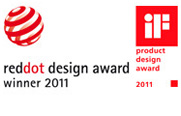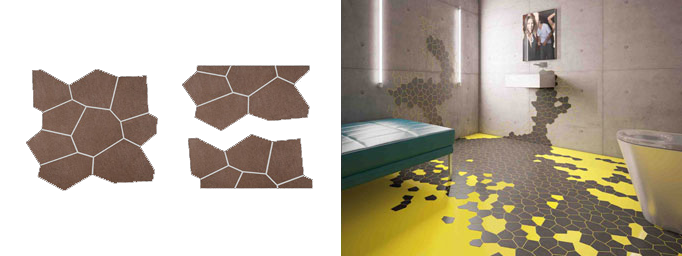POLYGON inspires on multiple fronts …

New 2011 tile innovation garners two prestigious design prizes

The iF product design award and the red dot product design award are two of the most prestigious contests of their kind, with both awards enjoying major national and international recognition as well as a high profile. This makes it all the more remarkable for a single product to win both prizes. A feat accomplished by the AGROB BUCHTAL brand with its Connect range in 2010. This achievement recurred in 2011 in the form of the Polygon decorative element, a new addition to the XENO range, which has been successfully asserting itself on the market since 2007.
Subtle creativity
This product involves porcelain mosaics picking up on the current theme of fractal patterns which basically feature repetition of similar cells, elements, shapes or structures. True to this concept, Polygon comprises irregular polygons which are not identical but rather so similar that they result in a harmonious image when combined. This subtle idea obviously appealed to both expert juries. Polygon gives rise to both creatively ordered and disordered laying patterns. Areas thus created can stop suddenly in the middle of a room or have definite borders. This is all made possible by intelligent delivery formats: the "main pieces" comprise 30 x 31.5 cm sheets supplemented by "top or bottom end pieces" featuring straight edges. Robust porcelain is the material used, permitting applications on both floors and walls. And enabling solutions in which the floor tiles are seamlessly continued along the wall where they dart upwards - or even the other way around. Polygon is available in five expressive colours ranging from natural jura white to a distinctive black, transforming mosaic tiles into a consciously perceptible and room-defining architectural element.
 |
| The POLYGON decorative element from the XENO range comprises irregular polygons encouraging creative laying patterns. Areas can be defined or stop suddenly inside the room as illustrated in the example (restroom in a nightclub). Extreme colour contrasts in the joins transform them into a design element while the actual room is distinguished by the mosaic tiles. |
Essential facts on both awards
The iF product design award was established as early as 1953. This time round, 2,750 entries were submitted from 43 countries. This high level is also reflected in the jury make-up which - as always - comprised a top body of international experts.
The same applies for the red dot product design award which was presented for the first time in 1955. Meanwhile, more than 4,400 creations were submitted from 60 countries.
Further information: www.red-dot.de, www.ifdesign.de



